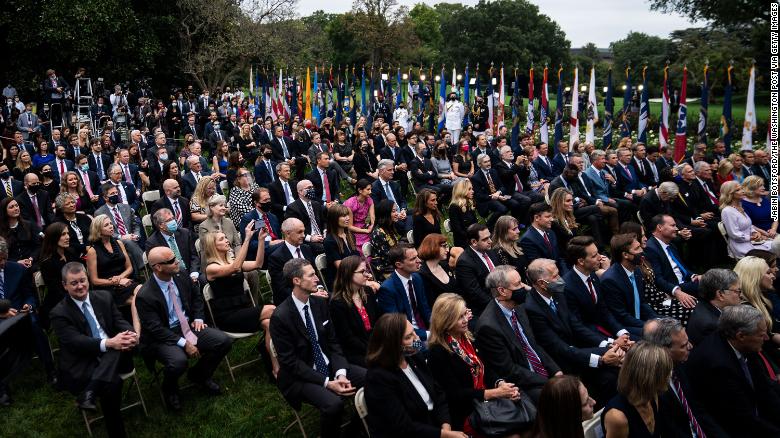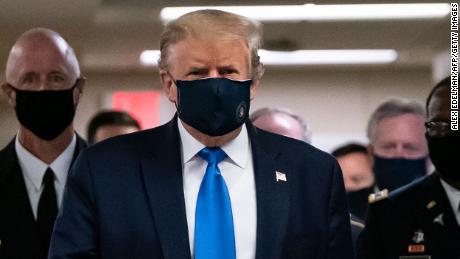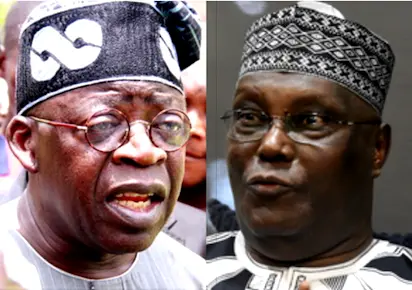An attempt by President Donald Trump’s doctor to reassure the public about Trump’s condition following his infection with Covid-19 only created widespread confusion and concerns about transparency on Saturday, as a source familiar with the President’s health told reporters that the next 48 hours will be critical in determining how he fares.
“The President’s vitals over the last 24 hours were very concerning and the next 48 hours will be critical in terms of his care.
We are still not on a clear path to a full recovery,” the source told White House pool reporters after the briefing from his doctors, the CNN reported on Saturday.
Moments earlier on Saturday morning, the President’s physician, Navy Cmdr. Dr. Sean Conley, had offered an upbeat assessment of the President’s condition stating that he was feeling well, that he had been “fever-free” for 24 hours and that his symptoms — which included an “extremely mild cough,” nasal congestion and fatigue — “are resolving and improving.”
Conley was evasive about when and if Trump had received supplemental oxygen, saying, “He is not on oxygen.”
But a source close to the White House said Trump has received supplemental oxygen since his illness began. Trump “definitely has had oxygen,” the source said, adding that it was on Friday.
The New York Times first reported the oxygen development. CNN reported on Friday the President was having a hard time breathing.
The rosy briefing from doctors, which contradicts other information emerging about the President’s condition, came the morning after Trump was transported to Walter Reed National Military Medical Center, a move that plunged the country into a deepening crisis as the circle of current and former aides to the President testing positive rapidly widened.
Conley said during the briefing — which occurred shortly before noon Saturday at Walter Reed — that the President was diagnosed with the coronavirus 72 hours earlier. He later released a statement midday on Saturday saying that he misspoke during the briefing and meant to say it was “Day Three” of Trump’s diagnosis — and that the President was diagnosed Thursday night.
Trump revealed his diagnosis around 1 a.m. ET Friday on Twitter.
Conley offered scant and insufficient details about the President’s vital signs. He acknowledged that the President had a fever at one point, but refused to say what it was. A person familiar with the matter told CNN before the briefing the President was still running a low fever Saturday.
Conley also declined to say when Trump had his last negative Covid-19 test or how many people in the President’s orbit may have been exposed given that Trump rarely wears a mask.
But one of the most confusing series of answers was about whether the President had received supplemental oxygen. Conley smiled when reporters tried to ask follow-up questions and repeatedly said the President is not currently receiving supplemental oxygen.
Another Walter Reed doctor treating the President told reporters at the Saturday news conference that Trump is not having difficulty breathing or walking today, and that Trump told doctors: “I feel like I could walk out of here today.”
Midday on Saturday, Trump tweeted thanking doctors, nurses and others at Walter Reed.
“Doctors, Nurses and ALL at the GREAT Walter Reed Medical Center, and others from likewise incredible institutions who have joined them, are AMAZING!!!Tremendous progress has been made over the last 6 months in fighting this PLAGUE,” Trump tweeted. “With their help, I am feeling well!”
Though Conley and Trump suggested a sunny prognosis, the treatments administered to the President in the past 24 hours have raised concerns about his condition.
While the President was still at the White House, he was administered the experimental Regeneron polyclonal antibody cocktail, a promising treatment that has not yet been approved by the Food and Drug Administration that was intended to help boost the President’s immune system as he fights the virus.
Once Trump was at Walter Reed, Conley said doctors initiated the antiviral drug remdesivir and that he will receive a five-day course of the drug, which has been shown to shorten recovery time for some coronavirus patients.
A widening circle
Conley briefed the press about fourteen hours after Trump was taken to Walter Reed. In the hours after Trump revealed his Covid-19 diagnosis early Friday morning, the circle of current and former aides to the President testing positive grew quickly.
By early Saturday, former White House counselor Kellyanne Conway and the President’s campaign manager Bill Stepien had both tested positive, which followed the positive diagnoses of two US senators who had attended Trump’s Supreme Court nomination announcement last weekend, and Trump senior adviser Hope Hicks on Thursday.
A third Republican US senator, who did not attend the nomination event, announced a positive diagnosis later Saturday morning. Former New Jersey Gov. Chris Christie, who had helped the President with debate preparations, also announced he had tested positive on Saturday.
It was a remarkably fast escalation of the virus’ threat — which the President has long downplayed — from an infection that caused him mild symptoms, to a fever to then being airlifted to the hospital, all while spreading quickly throughout the government and his campaign.
Conley issued an update on the President’s condition midday Friday, saying in a memo that the President is “doing very well” and had not required any supplemental oxygen, but that doctors had initiated the antiviral drug remdesivir.
In that memo, Conley said he recommended the President’s movement from the White House to Walter Reed earlier Friday in consultation with specialists from both Walter Reed and Johns Hopkins University.
Around the same time, Trump tweeted: “Going well, I think! Thank you to all. LOVE!!!”
Trump’s diagnosis — followed by his move to Walter Reed, where the White House said he plans to stay and work for “the next few days” — presented the most serious known health threat to the US presidency since former President Ronald Reagan was non-fatally shot in 1981.
The decision to take Trump to the hospital marked a sharp turn from the statement Conley made early Friday when he first confirmed the Covid-19 diagnosis of Trump and first lady Melania Trump, and said the couple would remain at the White House during their convalescence.
Wearing a suit and mask, Trump, who’s 74, gave a low-key wave to the press Friday but took no questions as he walked without assistance across the South Lawn of the White House to Marine One, the helicopter that airlifted him to the hospital Friday.
Before leaving for Walter Reed he received a dose of the experimental antibody cocktail — which may have signaled a rising level of concern among his physicians, Dr. Jonathan Reiner, CNN medical analyst and professor at George Washington University, told CNN on Friday.
Though White House staff claimed the President made the move “out of an abundance of caution, questions persist about the true state of the President’s condition, because of the consistent lack of transparency from this White House.
White House officials underscored that the President has not transferred power to Vice President Mike Pence, as is sometimes customary when a president is ill or scheduled to undergo a procedure that could require anesthesia.
The President “is in charge,” a White House communications aide said Friday, and Trump released a short recorded video on Twitter thanking his supporters for their well wishes as he arrived at Walter Reed shortly before 6:30 p.m. ET.
“I want to thank everybody for the tremendous support. I’m going to Walter Reed Hospital. I think I’m doing very well,” Trump said in the 18-second video, which was notable for its brevity. “We’re going to make sure that things work out. The first lady is doing very well. So thank you very much, I appreciate it. I will never forget it. Thank you.”
Melania Trump remained at the White House with what the White House physician described as a mild cough and a headache.
But her husband’s age, his sex and the fact that he is clinically obese put him at greater risk of complications from the virus. It was unclear exactly when the couple was tested and how long they could have been contagious.
The incubation period for the virus is estimated to be anywhere between five and 14 days, according to the US Centers for Disease Control and Prevention, and the agency’s guidelines say that anyone exposed to the virus should quarantine for 14 days.
A pattern of dismissing the virus
Following the same recklessness the President has shown throughout the pandemic, Trump decided to go to a campaign fundraiser in Bedminster, New Jersey, Thursday evening even though he had learned before the trip that Hicks, one of his senior aides who had traveled with him throughout the week, had tested positive for the virus.
The President traveled earlier in the week to the first presidential debate with Biden, who tested negative on Friday, in addition to his campaign events in Minnesota and New Jersey Wednesday and Friday.
There are increasingly troubling signs from the White House events last Saturday when Trump and the first lady hosted a sizable crowd in the Rose Garden as the President announced the nomination of Judge Amy Coney Barrett to the Supreme Court.
Guests did not socially distance and very few wore masks. At least seven people, including the President and first lady, have tested positive. University of Notre Dame President the Rev. John Jenkins, Conway and Republican Sens.
Mike Lee of Utah and Thom Tillis of North Carolina, who were seated relatively close to each other, tested positive.
A third Republican senator, Ron Johnson, on Saturday was reported to have tested positive for coronavirus. He was not at the Supreme Court nomination event because he was quarantining from a prior exposure, during which he twice tested negative for the virus, according to his spokesman.
White House guests who have tested positive for Covid-19
At least eight people — including President Donald Trump — have tested positive for Covid-19 after attending a Rose Garden event on Sept. 26, where Trump announced his choice to nominate Judge Amy Coney Barrett to the Supreme Court.
Lee was seen on video hugging other attendees. Barrett and her husband contracted the virus earlier this summer and recovered, according to three sources familiar with the matter.
Conway, Stepien and Hicks were all involved in the President’s preparations for his debate with Joe Biden on Tuesday. Coronavirus symptoms can appear within two to 14 days of exposure, but most often develop with four to five days.
A longstanding credibility gap
The lack of information about the severity of Trump’s illness Friday night was complicated by the fact that the President and his allies have downplayed the dangers of Covid-19 ever since the virus reached the US.
Trump and members of his administration already faced a major credibility gap because of their extensive history of putting out false or misleading information about a variety of topics over the past four years, including the severity of the pandemic and the risks to public health.
The descriptions of the President’s condition shifted throughout the day Friday — and much of the early information about his well-being was reported by the press first and then confirmed by the White House, underscoring the lack of transparency from this administration.
On Friday morning, as the White House tried to project a business-as-usual demeanor, chief of staff Mark Meadows described Trump as energetic. But later in the day, Conley, the doctor intimately involved in Trump’s care, wrote in a memo that he was “fatigued.” And CNN learned from another source that the President had a fever for much of the day.
In the Friday afternoon memo, Conley listed the medications Trump had been given including Regeneron polyclonal antibody cocktail, as well as zinc, vitamin D, famotidine, melatonin and a daily aspirin.
“As of this afternoon the President remains fatigued but in good spirits,” his physician wrote. “He’s being evaluated by a team of experts, and together we’ll be making recommendations to the President and First Lady in regards to next best steps.” Within a few hours, Trump was headed to Walter Reed.

Dr. Leonard Schleifer, the CEO of biotechnology company Regeneron, told CNN’s Wolf Blitzer that Trump would have received the experimental antibody treatment that his company manufactures to help boost his immune system, which he said is now in “a race” against the virus.
“If the virus wins you can have dire consequences, obviously, and what our antibodies do is we make it a fair fight,” Schleifer said on CNN. “He’s in a higher risk group for a variety of reasons, such as being older, and if we give our antibodies, we hope that we will give his immune system enough of a boost so that he can win this and make a complete recovery.”
An inevitable outcome
The President’s cavalier attitude toward the virus, his decision to keep traveling and holding large rallies, and the fact that he discouraged mask use by most Americans until late this summer made his eventual diagnosis all but inevitable — given how he has practiced behaviors that his own coronavirus task force has discouraged to the public.
As recently as this week’s presidential debate in Ohio, Trump mocked Biden for wearing a mask. In prerecorded remarks for Thursday night’s Al Smith charity dinner, the President proclaimed that the “end of the pandemic is in sight.”
He has continually undercut and contradicted the advice of his top medical experts as he has flouted public health guidelines by holding events with few masks and people in close proximity to one another, putting his supporters and their contacts at risk.
And as he tries to win reelection, Trump has insisted, in contradiction to the statistics and statements of the nation’s top infectious disease experts, that the US is rounding the corner in its fight against Covid-19, stating that it is time for Americans to get back to work and children back to school.
He has falsely argued that Biden wants to shut down the country instead of opening it back up, citing that as a reason why Americans should reelect him.
Throughout the spring and summer, both Trump and his aides continually answered questions from the press about why the President refused to wear a mask by insisting that he and the people around him are tested for coronavirus on a daily basis.
But many medical experts have pointed out that testing only offers a snapshot of one’s diagnosis at a moment in time and that it may have given White House staffers — and the President — a false sense of security as aides continually showed up for work at the White House not wearing masks.
At the debate this week, the President’s children arrived wearing masks, but took them off during the event.
On Friday evening, Trump’s son Eric made it clear in a tweet that this was no ordinary situation as he called his father a “true warrior” and asked the President’s supporters to join him in prayers.
“He will fight through this with the same strength and conviction that he uses to fight for America each and every day. I ask you to join me in praying for his recovery,” Eric Trump said on Twitter. “I have never been more proud of someone and what they have had to endure.”
This story has been updated with additional developments.
CNN.






